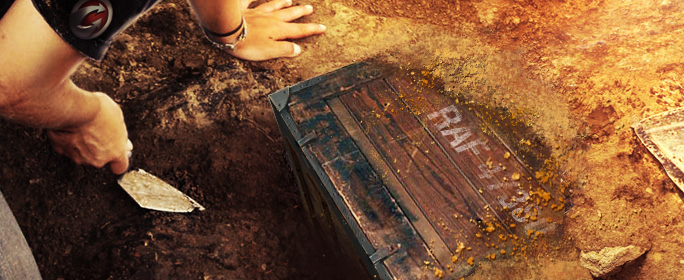-
![LANG-CODE-KEY]() LANG_NAME_KEY
LANG_NAME_KEY

At the end of the classic John Ford Western “The Man Who Shot Liberty Valance” newspaperman Maxwell Scott played by Carleton Young, turns to Senator Ransom Stoddard, played by James Stewart and says "This is the West, sir. When the legend becomes fact, print the legend". The story of the lost Spitfires of RAF Mingaladon is such a legend become fact.
Buried, so it is said, at RAF Mingaladon just to the north of Rangoon, as World War Two in the Far East drew to its chaotic close in the Autumn of 1945, the Spitfires of Mingaladon are also one of the most enduring and intriguing mysteries of World War Two.
|
Spitfire Memorial Southampton |
Martin Brown filming time |
Ground Penetrating Radar in use |
But how do you get to the truth behind such a powerful legend almost seventy years after the fact? Particularly when so many people maintain that this legend is true, repeatedly saying as much in the Media and on the Internet and when some are even prepared to back up their passionate belief with evidence drawn from years of documentary research, statements from witnesses, fieldwork and a considerable investment in time and money? We have decided we need to think of the search for the lost Spitfires of Mingaladon as a Police Procedural Thriller. We have a crime scene, the former RAF Mingaladon and we have a missing person, an undetermined number of Royal Air Force Spitfire aircraft. The job of our archaeological team on the Lost Squadron Project is to act as the investigating Officers drawing together all of the various strands of evidence available to us about events at RAF Mingaladon in 1945 in an attempt to determine where our missing person is, or even if they ever went missing at all.
Like Police Officers embarking on a major investigation we do not start with any assumptions. Instead we will be working through hundreds of pages of original documents, dozens of photographs and paintings and the many witness statements and expert testimonies collected by David Cundall and his co-researchers over the last fifteen years. We will also be looking at exciting new evidence located for this project and never previously examined.
We have to assess each item for reliability, accuracy and relevance and then use them in conjunction with our archaeological assessment of the information provided by Geophysics and the topography and geology of the site at Yangon, to turn those strands of evidence into a coherent case to target the archaeology and turn the hypothesis, rumour and speculation of the legend into facts in the ground provided by carefully targeted archaeology. Only once we have completed that process can we hope to come up with a credible, evidence led explanation for the legend of the Lost Spitfires and embark on the excavation which might finally answer the questions everyone is so keen to see resolved. That is what we do and we call it the Archaeology of Modern Conflict.
The Archaeology of Modern Conflict is the application of archaeological techniques to the study of communities preparing for, or engaged in, conflict of any kind, civil, or more often military. It is also one of the newest and fastest growing branches of Archaeology. Its popularity is driven, at least in part, by the enthusiasm and involvement of people researching their own local and family histories of involvement in the Conflicts of the 20th Century, principally World War One and World War Two and the iconic moments and artefacts those conflicts seared into popular culture and memory, from the blood stained fields of France and Belgium in World War One, through the skies of Southern England and over the Ruhr to the wide waters and islands of the Pacific and, in this case, the jungles of South East Asia during World War Two.
|
Rod Scott recording a WW2 Slit Trench |
Conflict Archeology in action |
Andy Brockman Biography Picture |
It is that direct relationship with the living participants and their families which makes the Archaeology of Modern Conflict, and projects like this one at Yangon, so special. Time and again we find that even with the millions of photographs, documents, films and personal memories to provide information and colour, we still find evidence in the ground through archaeology which can make sense of the poorly understood or even turn existing views and assumptions on their head. It is as if we could interview the Centurions, soldiers and families when we excavate a fort on Hadrian’s Wall and it is particularly apt and exciting that we can bring this new discipline to the study of events in the Rangoon area of Burma during World War Two.
Of the many stories to emerge from World War Two, the War in the China/Burma/India Theatre was one of the longest, bloodiest, most difficult and even at the time, the least known theatres of that whole terrible conflict. Not for nothing did the British 14th Army in Burma christen themselves the "Forgotten 14th". The Burma Theatre was a microcosm of the concept of World War, since the conflict the conflict in Burma did not just involve British, American and Japanese soldiers, sailors and airmen. We must not forget it also involved the Indian Army and Air Force, service people from China, Australia, New Zealand and South Africa and most importantly the population of Burma itself, including its 135 ethnic peoples who, in a measure of the political conflicts of the time might serve in turn the British the Japanese and perhaps both, as well as their own political aspirations for freedom from colonial control.
At Mingaladon we have the broad framework of dates and events, but much of the detail remains to be discovered and it is that detail which we believe the archaeology of modern conflict will provide and, we hope, enable us to complete the story of RAF Mingaladon and the legend of the lost Spitfires.